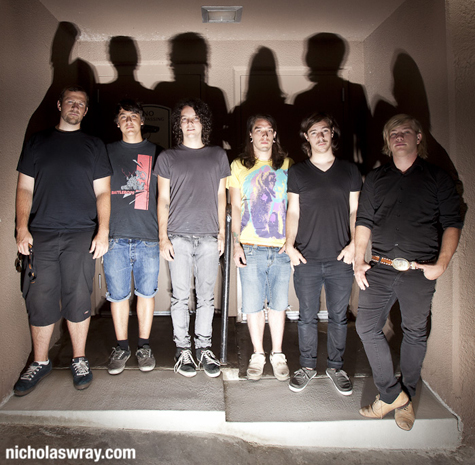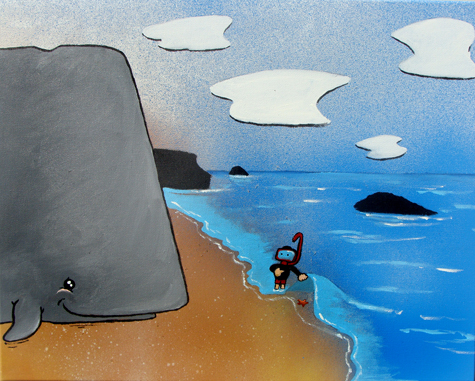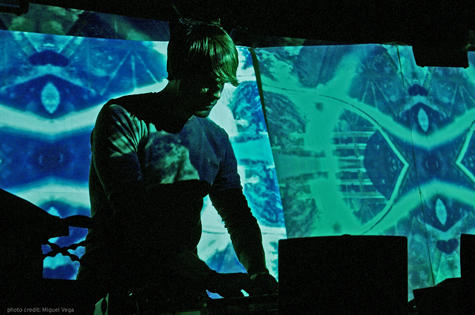A Lot Like Birds Readies The Release of Conversation Piece
It’s a quiet Tuesday night in Midtown and local progressive/post-hardcore band A Lot Like Birds has 80 or so fans packed into Luigi’s Fungarden as they tear through songs off their upcoming Doghouse Records full-length debut Conversation Piece, set for release on Oct. 11, 2011. Songs like “Think Dirty Out Loud” and “Sesame Street Is No Place for Me,” the album’s first two singles, have the crowd feverishly swaying back and forth to their spastic and energetic rhythms and riffs. Co-vocalists Cory Lockwood and Kurt Travis bounce around the small stage, shaking their long locks, taking turns singing and screaming, fully taking advantage of having co-vocalists (think call and response, harmonizing, layering, etc).
“I’m not the singer and he’s not the screamer,” Travis makes known as the two vocalists and I share a pitcher of Pabst Blue Ribbon at a local watering hole the Friday following the show. It quickly becomes apparent that this is an important point for them to get across. “We’re both vocalists,” he says. “I scream and I sing. And he screams and he sings. And we yell and we talk and we do spoken word. We do everything, we do all of it.”
Lockwood agrees and thinks of it like this, “I feel like a lot of times with dual vocalist bands that have a singer and a screamer, you’re diverging your fans and you’re going to have people that go, ‘Well I listen to the singing,’ and then you’ve got the guys who want tough music and they’re like, ‘Well I like the screaming.’ So if you bleed both of them, you’re forcing people to like it as a whole.”
Couple the outrageous and entertaining vocal work from Travis and Lockwood with the equally impressive instrumental work of the rest of the band, which consists of guitarists Michael Franzino and Ben Wiacek, bassist Michael Littlefield and drummer Joe Arrington, and you’ve got yourself one interesting record in Conversation Piece. One that crosses genres, tears down boundaries, leaves the listener wondering, “What’s next?” after each track comes to a dramatic close, and one that will most likely take a few listens to grow on you. They are aware of this.
“I know that music like this has to grow on people. People are really slow at picking stuff like this up,” says Travis.
“It’s almost easier for us to do weirder stuff,” Lockwood admits.
And weird it is, although we’re not talking about an un-listenable type of weird here; this isn’t just random noise after all. We’re talking about calculated time signature changes, non-traditional song structures, heavy-hitting breakdowns mixed with luscious reverb and delay-ridden clean parts, impressive and off-the-wall guitar riffs and interesting lyrical content to boot. Take the following lines from “Think Dirty Out Loud” for example, where Lockwood screams, “I spiked both our drinks with a gallon of ink / Now I’m writing a novel from your insides / We’re a spider with our limbs doing anything but walking / A conversation with our mouths doing anything but talking.” Or where Travis sings, “I eat emotional wrecks / And yours is the best.”
“I remember the instance in which we started writing the lyrics,” Travis says of the song. “I was totally enjoying myself, just laughing to myself, just thinking I’m the most clever fucking person ever.”
It is noteworthy to point out that in a number of ways, Conversation Piece is entirely different than A Lot Like Birds’ last offering, 2009’s Plan B. The latter was largely the work of guitarist and songwriting catalyst (as well as the band’s original vocalist) Michael Franzino, who invited a horde of local musicians to play everything from trumpet and trombone to cello and violin on the record. Plan B didn’t even feature a live drummer, as Franzino programmed the drums himself via computer. Conversation Piece is much more of a collaborative effort and consists of mostly the band’s core instruments (guitar, bass, drums, vocals), although it does contain some programmed stuff (“A Satire of a Satire of a Satire is Tiring”) and a little bit of horns (“Vanity’s Fair”) as to not depart completely from the band’s tendency to blend live instrumentation with orchestral and programmed elements. One of the most obvious differences between the two records is the solidified lineup, which includes the recent addition of Travis, who up until this summer had spent the last couple years co-fronting another Sacramento-based post-hardcore band, Dance Gavin Dance. “There’s four new members,” Lockwood says of the post-Plan B lineup. Travis interjects, “I’m not the new guy, you know what I mean? I’m the newest by all means. But Plan B was pretty much one or two guys, now this record is everybody giving their opinions and whatnot.”
For the recording of Conversation Piece, A Lot Like Birds turned to Portland, Ore.-based producer/engineer Kris Crummett, a familiar face to Travis, they have recorded two DGD albums together (2008’s self-titled record and 2009’s Happiness).
“As soon as I got kicked out of Dance Gavin Dance, Kris hit me up and was like, ‘Let me know what you’re doing, whatever you do, just let me know,’” Travis remembers. “It was kind of interesting because when I joined A Lot Like Birds, they were already talking about and thinking about going with Kris Crummett. I love that guy, we have a good history; we have a good thing going on.”
The band worked rigorously with Crummett for three weeks, focusing all of their creative energy on the record, which wasn’t even necessarily completely written yet, as Travis and Lockwood both had a fair share of lyrical work to do while in the studio.
“Everybody was hella trippin’, but that’s kind of how I like to work anyways,” Travis says of the high-pressure situation to complete basically half an album’s worth of lyrics on the fly. In the end, things worked out beautifully for the two vocalists, who found themselves locked in a room with Crummett for hours on end, pounding out vocal ideas together.
“I don’t think either of us had any idea how well we were going to work with each other,” Lockwood says of co-writing. “I’ve never worked with another vocalist before.” Travis pointed out that because the group was away from the everyday distractions that come with being home, they were able to channel everything they had into the record. “When you’re in your home town and you have all your stuff, you know, you have your job that you go to, you’ve got your girlfriend, you’ve got your parents and all this stuff. Sometimes it’s distracting,” Travis says. “I hella missed that when I was a full-time touring musician. You kind of just focus on music. So when I got to Portland, I was just kind of like, ‘Ah, I don’t have to think about anything other than just this record,’ and it got all of our attention.”
Even still, the band didn’t finish everything they needed to in their allotted time with Crummett, and they had to record one song in Sacramento with friend and sound engineer Chris Miller. Crummett was still producing even from hundreds of miles away, though, as the band Skyped him during the sessions with Miller.

“He was still there like being able to hear the takes,” Travis says with a chuckle at the thought of Crummett’s face on a computer screen in the room for hours on end.
“He was just like eating Chinese food and shit,” Lockwood says through a laugh while air shoveling a bite of imaginary food into his mouth.
After three weeks spent in Portland with Crummett and a couple more days’ worth of sessions with Miller in Sacramento, the record was finally done, or so Travis thought. “Knowing my luck, we do like two days with Chris and then we get everything done and we’re like, ‘Yes! Fuck yes, it’s done,’” Travis says. “And then I get a call from my guitar player and he’s like, ‘You’ve got to come back and do some more stuff,’ and I was just like, ‘Dude, when is this going to end? We’re not even in Portland anymore.’ But it was completely worth it and the song came out way better than I even thought it could.”
In between the Portland and Sacramento recording sessions, A Lot Like Birds even found time to embark on a week-and-a-half long West Coast tour. It proved a good opportunity to work out the brand new material in the live setting and to gauge people’s reactions to it as well. “It was really like a testing the waters sort of thing,” Travis says. “To see who gives a shit right from the get-go. It was a good response!”
Lockwood recalls one particular night in Anaheim when a girl came up to him at the merch table after the show and told him that she hadn’t heard music like theirs in years, since the early ‘00s. “That’s definitely when I started playing music, that’s when we both started getting really into it. So if anything, if we draw comparisons to stuff from back then, that’s all I’d love to hear.”
Unfortunately for A Lot Like Birds, references to the sounds of the early ‘00s aren’t the only comparisons they’re receiving, as a large number of people (mostly via the Internet) are saying they sound too much like Dance Gavin Dance. No doubt there will be comparisons: both bands are from Sacramento, both have two singers, both have ripping guitar players and rock-solid rhythm sections; heck, they even recorded with the same producer, so yeah, sonically speaking there are some similarities too. But what’s funniest to Travis and Lockwood about the whole situation is that these quick judgments are coming from the album’s two singles, because those are the only two songs off Conversation Piece that the general public has heard.
“People have been really quick to go, ‘Oh, this is what their whole album is going to sound like,’” Lockwood says.
“They don’t even know how versatile it is,” Travis contends. “You know how the Internet goes; people are very, very quick to judge. It’s funny, it’s almost tickling. They have no idea. It’s going to be cool, because they’ll realize it when it comes out.”
Travis also wanted to get off his chest how he feels for Lockwood, who seems to be receiving the brunt of the reviews. The problem? Apparently he screams too much like Jon Mess, DGD’s co-vocalist. “Dude, if you have ears, you would know that it’s completely different,” Travis demands. “Their screaming styles are completely different. It’s just kind of like Jon Mess is the only person they can reference. It’s so funny, like when people compare me to Jonny Craig [DGD’s original vocalist who replaced Travis when he re-joined the band this year], it’s like, ‘Are you fucking retarded? Do you actually have ears? Because I sound nothing like him.’ Not that I couldn’t sing Jonny’s stuff and not that Jonny couldn’t sing my stuff, it’s just, we don’t sound alike. It’s the same thing with Jon Mess and Cory, and I just feel for him.”
Travis has gotten his fair share of attention, too, ever since his departure with DGD. “It’s just something that you have to deal with,” Travis says of constantly being asked about his situation. “It’s like one of those things about your job that you hate but you have to do anyways. I kind of relate it to that, because no I’m not upset, no I’m not tired of it. It’s just one of those things that I know that I’m always going to have to address and that’s fine. If I didn’t have all of that then I wouldn’t have any of this amazing stuff that’s going on right now. So, I think of it that way. Not like, ‘Oh man, I don’t want to talk about the past.’ All of that shit needed to happen in order for this amazing stuff to happen. I look at it like that so I’m not upset when someone is like, ‘What was it like? You got kicked out! Blah blah.’ I’m like, ‘Yeah, I did, but things worked out.’” And if you’re wondering, everything is cool between all the members of DGD and A Lot Like Birds. So much so that the two bands will share the stage together on Thursday, Oct. 13, 2011 at Sacramento State’s University Union.
After weeks spent listening to an advanced copy of their new record, an hour spent over beers at a local pub and a killer live set witnessed, it’s apparent to Submerge that A Lot Like Birds are their own band with their own identity and their own sound. Conversation Piece is no doubt the record that will solidify that and as of right now, getting the album out and into the hands of people who care about it is the only thing on their minds. With a grin from ear to ear, Travis says, “I think things will pop off real fast once that happens.”
A Lot Like Birds’ Conversation Piece will be out on Oct. 11 via Doghouse Records. See them live at Sacramento State’s University Union Ballroom alongside Dance Gavin Dance on Oct. 13. Sacramento’s own Ten After Two will also perform. Tickets are available at the University Union Box Office.
Tree House Dinners are Truly a Movable Feast
Words by Adam Saake – Photos by Debbie Cunningham
The sun went low, and at a touch before seven, a light breeze swept over the Midtown Victorian porch, cooling guests from the belated summer heat. Small, natural artifacts of sticks, kumquats, found rocks and candles were scattered on overhangs and railings. On a table in the corner, a bottle of Sommariva Prosecco was submerged in an ice-packed watering can and flutes were filled at leisure while brown paper bags of popcorn with fresh dill were passed around. A total of seven guests, strangers, were quickly sharing stories and salutations over ceviche and cucumber. This was the beginning of chef Kevin O’Connor’s underground dinner he whimsically calls Tree House.
“The name Tree House came to me at 4 a.m.,” says O’Connor. “Tree House evokes juvenile thoughts and I aim to do the same with my style of cooking.”
O’Connor himself might be the only thing juvenile about what goes on at Tree House (which by the way is at a table in his dining room). The talented young chef of Ella, and most recently its sister restaurant, The Kitchen, is a mere 22 years old. A clean-cut red head who looks more relaxed in a cut-off Iron Maiden t-shirt than he does in a chef’s coat, this cooking star in the making worked his way from dishwasher up–sans culinary school. As a teen, he hopped around different restaurants like Masque and Bistro 33, but things took a sharper turn when he moved downtown and began cooking at Mason’s, now Cafeteria 15L.
“I helped open MiX and shortly after the opening I moved to the South of France for a few months,” says O’Connor. “After culinary enlightenment dans la sud, I came back home to Sac and joined Kelly McCown at Ella shortly after he came.”
It was this trip to the South of France that would later become the inspiration for his monthly underground dinners.
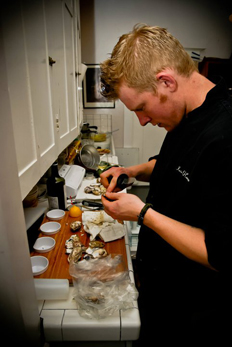
“Tree House began after I moved home from France. Every Sunday for a month and a half I would make dinner for my host family and their friends while I was in France,” O’Connor remembers. “These dinners were coursed out and showcased my creativity that was flowing while I was exploring food Mecca. I used produce from the farm, the town market, neighboring farms, hunting, foraging, and wine from their winery.”
The Tree House dinners are something to that effect, except O’Connor doesn’t have France or a farm–in spirit, sure, but he did have the winery this time. Craig Haarmeyer of Revolution Wines supplied all the wine pairings for the latest dinner, including the current vintage of their award-winning port.
Guests were leisurely enticed inside to sit at the table, well lubricated with Prosecco and conversation and ready for what O’Connor had up his sleeve. Once seated the night began with an amuse bouche, a small introductory appetizer that literally translates to “mouth amuser,” which consisted of prosciutto, pan-fried quail egg and a house-made hollandaise sauce. It was served simple and elegant in a Chinese ceramic soup spoon. Down the hatch. This single bite immediately excited the table and was a clear window into O’Connor’s cooking philosophy; one in which breakfast was clearly fair game for his introduction. Revolution’s Verdelho port, a sweeter white, paired beautifully, and we were on our way.
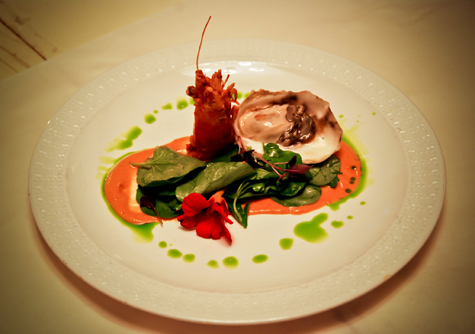
O’Connor’s plates have a touch of seriousness mixed with a pinch of brilliance and are lathered thick with humor. He grinned as he described courses like the pistachio encrusted foie gras with roasted peaches, calling his concoction “a foie gras candy bar.” His time in France came out in this dish too. He explained to the table one of the first and most memorable meals he had that was simply a bowl of pistachios, some peaches and a bit of foie gras. This was his translation–and what made each course so fantastic. He cooks off the pure joy of his memories with a little help from random musings.
“I’m inspired by the strangest things sometimes. A walk by the river, a 2 a.m. junk food binge, my food-filled childhood,” says O’Connor.
That “food-filled childhood” that O’Connor attributes to his father introduced a standout dish that was a play on mustard chicken. O’Connor’s father would make him a comforting plate of mustard chicken with a panko crust when he was a kid. To do honor, the most visually attractive plate of the evening arrived. Chicken rillettes with a half-moon toast was presented on a square, gray stone slab, dusted with an orderly stripe of honey mustard pretzels and garnished with a circle of pepper and mustard flowers. Rillettes is like a pate where the meat is slowly cooked in fat, duck fat in this case, and then is cooled and served like a spread. O’Connor “marinated the chicken, cured it for a day and braised it for about four hours,” to give it the texture and consistency he desired. This plate stood out the most and really showcased O’Connor’s creativity and technical execution.
An eight-hour sous-vide pork belly with barbeque beans, compressed watermelon and a salad of pickled watermelon rind (an ode to summer, perhaps) was followed by a simple offering of local goat’s milk cheese, Bing cherries and thyme flowers. Simple and to the point; elegant and delicious. Each course offered a new idea, an interesting thought or an adventurous leap to take (O’Connor encouraged guests to suck the brains from a fried prawn head during one course). The Tree House dinner finished with a mind blowing dessert course of cinnamon sugar toast, maple blueberries and a cereal milk anglaise for dipping that was inside of a hollowed-out egg shell. Guests enjoyed port to pair and moments of silence swept over the table as plates were literally licked clean.
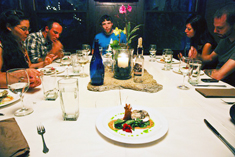
A satisfied Tree House assembly took refuge on the porch, enticed by 15-year aged Glenlivet scotch being poured from a transparent globe decanter. O’Connor emerged from the house, sans chef coat and ready to be part of the conversation. His left arm is tattooed with a crude chef hat, crossbones and knives with the mantra, “Cook to Live, Live to Cook.” “It’s being covered soon,” he said. But, there’s no hiding his passion for food and for the people he cooks it for. And as hidden as the underground dinners might seem, there is a Facebook page and O’Connor has special wording that keeps him out of trouble–for now.
“We aren’t a real underground restaurant…we are a ‘private dining cooperative’ where like-minded foodies pitch in for dinner that happens to be at a residence,” says O’Connor.
Where he takes these dinners is up in the air for now, but there’s talk of catering, pop-up events and cocktails in alleyways. Ideas are flowing and O’Connor’s love of Sacramento will keep him right here for those adventures.
“I’m inspired by the people that say Sacramento sucks and by the people that have faith in it becoming a food city at the same time. I want to start forming a Sacramento cuisine,” says O’Connor.
One Tree House at a time.
Tree House dinners happen once month at an undisclosed location in Midtown. For information on how to register, visit Facebook.com/treehousesacramento or Treehousesacramento.blogspot.com

MVP’s Sports Grill, located at 21st and L streets in Midtown, is calling all domino players to attend both their Slappin’ Wednesdays for games and drinks every single Wednesday as well as their domino tournament on Saturday, April 16, 2011. The tourney will feature a cash prize for the winner and there’s no entry fee or buy-ins. It’s limited to only 24 players and it’s first come first serve, so if you want to compete make sure you show up early. Player check-in is scheduled for 7 p.m. DJ Los will be spinning some tunes also, so grab some friends to cheer you on–and bring your A game, because there’s cash on the line. For more information, give MVP’s a call at (916)-441-4151.
On the art of Danny Scheible
Words by Bobby S. Gulshan
In the last few months of 2010, Sacramento’s Second Saturday Art Walk emerged as a hotly contested locus of debate. People wondered out loud if the event had strayed from its original mission; was the benefit to Midtown businesses and artists enough to justify the risks? Because opinions abound on both sides, we will likely not see any significant change to the Second Saturday event any time soon.
One thing, however, stood seemingly beyond contention: the art community is an important and integral part of the Midtown scene and of Sacramento in general. The amount of activity within the visual arts in Sacramento defies the notion that a vibrant art community that generates meaningful and important work can only exist within the major metropolises of New York or Los Angeles. To be sure, those cities remain important cultural centers if for no other reason than the sizes of the markets they inhabit. Yet, as artist and sculptor Danny Scheible tells it, there is something special about making art in Sacramento.
“You meet people here and they want to help you,” he says. “There is a community already there. Having been to bigger cities, it’s very much an exchange, what can this person do for me?” This sense of community, of art as the beginning of a practice of going beyond oneself, or perhaps toward some more complete version of the self, resonates centrally in Scheible’s work.
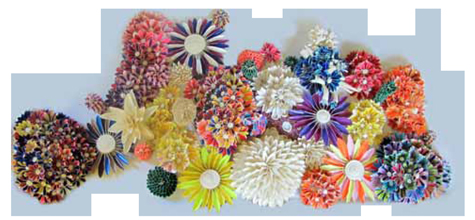
In sculpture, materiality and spatial context play vital roles in the interaction of the art object and its observer. As Danny and I spoke, he crafted flowers and other more abstract objects from rolls of masking tape. “Tape is something that everyone has in their house or wherever, so it’s something people can immediately identify with,” he says. “But it’s also about taking that everyday object and seeing the aesthetic potential in it.”
This intentional choice represents a movement toward the audience, toward their cultural and social location. With respect to spatial location, Scheible sees the importance not just of the gallery setting but of public space. While it brings with it some level of anxiety (things being damaged, openly criticized) venturing into public space is a further gesture toward the audience. In this case, it is to de-familiarize the everyday and punctuate it with an aesthetic gesture. “I might put a small piece out somewhere and then stand across the street and watch and see how people react, or I may leave things along my walking paths,” he says. Scheible will chronicle reactions, and these impressions further inform his process. In this way he is, as he says, “constantly creating myself as a person through my art.”
Scheible is the self-proclaimed “Art Ambassador of Sacramento.” His primary diplomatic function seems to be to inject into the experiences of his artwork–and thus himself–a dialogue or process by which further discovery can be made. “It’s a spiritual or meditative practice,” he says.
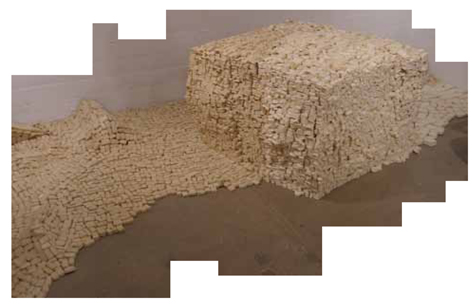
Many of our notions concerning modern sculptural works come from either our experience of sculptural objects in a gallery setting or the placement of sculptures in public places such as parks or commercial centers. These experiences tend to remind us of a kind of critical distance that exists between the object and the observer. In the case of minimalist sculptural works, the movement of the observer is a sort of theatrical gesture, but the object remains mute, having no specific relation to the audience other than its spatial fixedness. Scheible’s entire practice, and indeed process, seeks to reinvigorate this relationship with a certain kind of intimacy. In the works that he has given away, Sheible has encouraged others to produce drawings of his work that may subsequently be used as screen-print images, or alternately as hand drawn images, which again become the subject of his own process, as a sort of perpetual feedback loop. And this is key: The constant dialogue, or even dialectic, that generates the self through the process of offering forth the piece, having it reflected, and then taking that reflection as the starting point for the next iteration of work.
Scheible tells me, “I was born and raised in Curtis Park, and I live here now.” Locality is key to his process. The dialogue with the audience requires an immediacy that his interventions in space reveals. However, I don’t suspect that if Scheible keeps it up for long his bounds will be geographically limited. There exists a crucial point at which his art dares to reach into a universal realm: “An artist isn’t something you are born as, it’s something you make yourself into.” For Sheible, this is as much material and spatial as it is social. As he tells it, his strength lies in getting other artists to work together, to show together, and to promote together. This is a fundamental characteristic of anyone who dares to push the art that they believe in to the fore, and make it geographically and socially relevant.
We could have spent hours talking about the importance of public versus private space, or how hard it is for an artist to fix the damn scooter when it’s wrecked. But I look forward to an upcoming solo show, and the show he is curating, all here in our ever-vibrant Midtown arts scene.
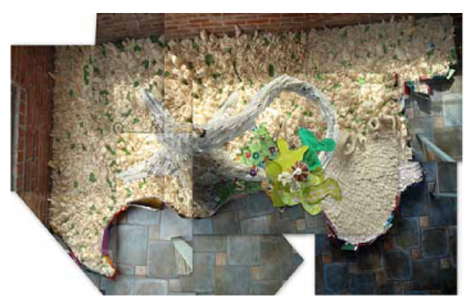
Danny Scheible’s latest solo show at Lauren Salon will have its opening reception during Second Saturday in March (March 12, 2011). Scheible’s curated show will take place at FE Gallery and will also have its opening reception on Second Saturday in March from 6 to 9 p.m.
DJ Shaun Slaughter Talks his Trade as Lipstick Turns 10
Words by Adam Saake – Photo by Matthew Burks
A jazz album plays in the background of Shaun Slaughter’s Midtown apartment as I sit down to discuss the 10-year anniversary of Lipstick, his indie dance club at Old Ironsides here in Sacramento. I guess maybe I expected a Phoenix song to be playing, or something along those lines, but then it all makes sense.
“I don’t want to have to play ‘1901’ ever again,” says Slaughter, half-joking. “I love that song, but I love it so much that I don’t want to play it so I don’t ruin it for myself.”
It’s like making burritos all day: you don’t hate burritos you just don’t want to have one right when you get off work. Alright, bad comparison. Indie rock isn’t really like burritos. But imagine for a second that Slaughter and Lipstick-partner-in-crime, Roger Carpio, are the tortillas. Wrapped up inside of these two musical encyclopedias is a plethora of songs that each have dug up from the depths of record bins and music blogs to play for a finicky crowd, week after week, year after year. Maybe you can’t eat Mexican food every day, but many faithful Lipstick-goers show up damn-near every Tuesday to see what the boys have drummed up now.
It wasn’t always as packed as it is these days; it was a bit of slow climb. And in the beginning it wasn’t always just Slaughter and Carpio. The original Lipstick lineup consisted of four DJs who all had very different ideas about how the night should sound. But what unified them was one simple idea–make them dance.
Slaughter was friends with a fellow house-head named Chad Nardine. Both he and Slaughter were new to downtown. Slaughter himself was a kid from the suburbs and barely 21, and they were given a slot at the Press Club to DJ. They cut their teeth there for a while but frustrations with the manager and too many randoms walking in requesting Madonna had them looking elsewhere. They were then approached separately and asked to DJ at Old Ironsides on one fateful Tuesday. Realizing they had both been solicited for the same gig, they of course decided to do the night together.
“Our first Tuesday ever was just Chad and I, and it was all electronica and it bombed,” says Slaughter. “No one was there!”
The two needed to revamp, so they went back to the drawing board to figure out how they were going to put together a better club night that would hit. The two of them were growing tired of DJing dance music and Slaughter had a taste for older alternative rock like the Rentals, Weezer and Sonic Youth. Nardine picked up on this and told Slaughter about Carpio.
“Chad said, ‘I have this friend named Roger who’s really into Britpop,” recalls Slaughter. “And I had no idea what that even meant.”
Carpio added his own ideas to the sound of the night and each peppered in their unique styles. To round out their indie rock dance night, Roger brought one more DJ into the mix.
“Then Roger said, ‘I know this guy Sean Meyers who DJs really good ‘60s rock.’ We heard him play this set one night, and it was just amazing. We added him on and then it was the four of us,” says Slaughter.
During that first year of Lipstick at the Press Club, the four played to lackluster response and were perfectly OK with that. The few that showed up showed support the best way a DJ could hope for.
“It was good, and we were happy with 30 or 40 people,” says Slaughter. “We couldn’t believe that people would dance to it.”
Nardine eventually ended up moving away and Meyers excused himself to pursue other endeavors. That left the two DJs, Slaughter and Carpio, who couldn’t have been more different from each other. But what at first may have seemed like a duo doomed to butt heads, disagree over music choice or altogether fail as partners ended up being the exact right pairing that would keep Lipstick running after all these years.
“We were both really particular about how the night went,” explains Slaughter. That’s why…it’s been around so long. Both of us were really stuck on the fact that it had to be a certain way.”
And that certain way was “some indie, Britpop and some old stuff” as well as no guest DJs. Whatever they were playing, they were doing something right and that mindset of sticking to a format was the foundation that drew in crowds night after night. Over time, though, the box they DJed inside of eventually proved to be too small and it was time for more legroom.
“I think that if we would have stuck with that, it would have just died out, because ultimately people don’t want to listen to the same stuff,” says Slaughter.
So again, what the two shared in common was what kept Lipstick new and interesting over the years. Their shared passion for discovering new music coupled with Lipstick happening every week made for the right motivation to keep introducing the dance floor to new bands.
“Roger and I are super avid. All we do is dig for music and listen to new stuff,” says Slaughter.
At times it can be “a double-edged sword” Slaughter says, hand on his chin and thoughts on his mind. Keeping the night always new and always changing is fun when you’re a DJ because you’re never playing anything out. You’re able to keep a song like “1901” for your own enjoyment. Yet, certain songs are guaranteed to pack the dance floor and in the end, isn’t that your job as a DJ?
“You’re doing people a disservice if you don’t play some of that stuff,” says Slaughter. “You do it every Tuesday and you’re thinking, ‘Fuck! I’ve heard this song so many times.’ But then I think about the people who haven’t been coming every week and how excited they are to dance to a song they’ve never heard before.”
It’s rare for anything in the music and art scenes to last 10 years, let alone a club night. People change, bars close, relationships go south. It’s just the way it is. For Lipstick to have endured 10 years on an ever-changing music scene and all the while under what seems like constant scrutiny from naysayers calling Lipstick a club night for “hipsters,” is pretty amazing. This common misconception is immediately squashed when you walk through the doors on any given Tuesday. It’s a shot in the dark as to whom you’re actually going to find inside at the bar. Most likely you’ll find those same naysayers who are socializing with the “hipsters” while buying shots for your introverted co-worker from the office.
“We’ve gone through so many waves,” explains Slaughter. “Roger is like, ‘Dude. How many times have we gone through this?’”
Maybe that’s why Slaughter and Carpio have stuck it out all these years. Keeping the crowd showing up is one thing, but keeping themselves interested is another. But when each year brings a new crowd, with new friends and more good times to add to the memories, it makes it easier to stick around. Plus, Slaughter and Carpio switch it up around town and have been behind the wheel of many other successful, and most importantly, just really fun club nights around Sacramento. One of their most popular nights, FUCK Fridays at the Townhouse Lounge, is their sort of alter egos where they can completely let loose. Here they promote a “let’s lose our shit and go completely crazy” attitude while Slaughter is dressed up as say, an M&M or a rat costume [pictured].
What people don’t always realize is that many DJs and promoters in Sacramento, including Slaughter and Carpio, have their finger on the pulse of what’s good in the music and club scenes around the country. Slaughter frequently travels to other cities to DJ, and when he returns he brings back with him the best ideas he’s encountered to apply to his own club nights. In the words of Slaughter, “We stole everything from somebody.” Although, I prefer borrowed, for what are ideas without inspiration?
“Everyone always thinks there is something better,” says Slaughter. “Compared to a lot of other cities, we’re actually doing pretty well. The nights we’re throwing are really current.”
Recently, Slaughter has been focusing his energy on the production side with a new project called D.A.M.B. that just got picked up by DJs Are Not Rock Stars Records. “Daylight,” his first track released, plays with samples of Harry Belafonte’s “Day-O” backed by a tropical house beat. His second track, “Waiting,” has already been remixed by the LOL Boys, Mom & Dad and Wolfie and has found its way around a number of high-traffic blogs. Not too bad for his first two tracks. We’ll see where it goes in the coming months, seeing as how Slaughter has his hands pretty full booking up-and-comers for FUCK, scouring the Internet for Lipstick and doing the graphic design for all his flyers. It’s a lot of work, but he’s managing to make a living doing what he loves.
“I’m definitely super, super happy. I could be playing Top 40 every night,” says Slaughter. “I get the privilege of DJing with Roger too, and I get to hang out and get paid to do something amazing. I think it’s insane that after 10 years people are still there.”
Here’s to another 10.
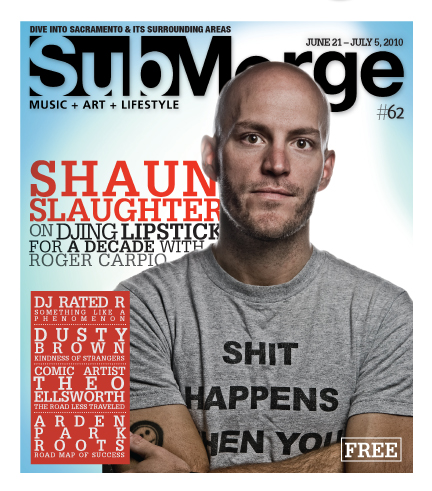
Check out Lipstick Tuesday nights at Old Ironsides. For more info, go to www.blasefaire.com.
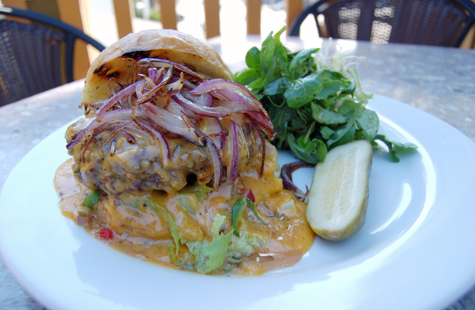
Kupros Bistro
1217 21st Street – Sacramento, Calif.
Words & Photos by Adam Saake
Kupro is Esperantan for copper. If you’re like me, you’re asking yourself, “What the hell is Esperanto?” Esperanto, a language all its own, was developed in the late 1800s as a way to create a middle ground for the people of planet Earth to speak with one another. But it never caught on, and now only a small percentage of people in the world care enough to learn it. Kupros Bistro, a wonderful new gastro-pub located in Midtown, will hopefully not suffer the same fate. If we could draw a comparison, although, it would be that Esperanto is apparently very easy to learn as Kupros’s menu is very easy to love.
What was once a popular costume shop by the name of Cheap Thrills is now a completely remodeled two-story destination for food and libations. Playing off the traditional English pub, Kupros offers a comfort food menu with a touch of finesse. Move over, fish and chips; step aside, bangers and mash–ciao, linguine and clams, bon jour duck confit Rueben.
On my late afternoon visit, the lunch crowd had dispersed and I had the second-story patio all to myself. Inside, a multitude of tables all set and ready to go loomed like a ghost soiree waiting to be possessed. “Banquets,” said my server. Hopefully, because the amount of seating available seemed a little ambitious for what is essentially a pub. Outside, the patio overlooked the busy motorcade that is 21st Street, and umbrellas lined the banister, shading diners from the lingering summer rays and the wind-disturbed pollen and tree debris. Downstairs had booth seating and the U-shaped bar looked very inviting if you like getting friendly with the bartenders. Their draft beer selection had some keepers, including a Belgian-style saison from Lost Abbey and an English-style cider from Fox Barrel. And intentional or not, there was a humorous coupling of Stone’s Arrogant Bastard Ale and Flying Dog’s Raging Bitch.
For the appetizer, I tried the fried pickles ($5) with a house tartar sauce. It’s of note to mention that all Kupros sauces are house-made, all the way down to the ketchup. Four lightly battered and fried wedges of tangy dill pickles are served modestly in a cocktail glass with a napkin back to absorb the excess oil. The tartar is pretty standard, but this dish doesn’t need to reach for the stars; it’s meant as a salty treat to go smashingly with a frosty pint. This isn’t a dish you grow tired of quickly and this is in part to the batter. It isn’t layered on so thick that you have a hard time finding the pickle.
It’s important to order the burger from time to time, because so many places do it differently. You never know when you’re going to stumble upon a truly great rendition of an American classic. As far as Sacramento goes, Kupros’s natural Angus burger with beer cheese, house relish and “drive-thru” dressing ($13) ranks up there in my top three. Aside from a great patty of beef cooked right and a fresh bun, the beer cheese turns this burger from good to great. This fondue-like concoction is a combination of cheddar cheese, lager beer and shallots, which is then smothered over the patty to make for coagulated goodness. Add some grilled onions and you’re dynamite.

I’m a salty and sweet kind of guy, and although dessert at lunch is a little overkill, I just couldn‘t resist. Amongst other interesting treats, Kupros does a vanilla bean panna cotta with chocolate cookies ($8) that have a frosting center (essentially a beefed-up Oreo) made by one of the Kupros pastry chefs, Jodie Chavious. Panna cotta is a traditional Italian custard usually made with cream, milk, sugar and gelatin and the flavors vary from caramel to blackberry. Chef John Gurnee throws a little buttermilk in there to give it a nice tang. This desert is uncomplicated, rich and fun to look at too. Indulge.
The dinner menu has some items not available during the day, including a delicious potted rabbit that I tried on a previous visit that was literally served in a latch-top pot. The kitchen stops serving at 10 p.m., so get your orders in before the night sneaks up on you. Also, Kupros is closed on Mondays and the kitchen takes a little break from 2—3 p.m. so plan accordingly.
Cafe Rolle
5357 H Street – Sacramento, Calif.
Every year when summer finally shines fully upon Sacramento, residents are shocked at the heat waves splashing over our city. But frankly, summer is synonymous with heat. Perhaps that’s why so many choose to live here. With heat, the barbecue gets used, the sprinkler gets run through, many visits occur to the park and the movie theater, we make sure our friends with boats take us out on the river. It’s a beautiful thing and we love summer.
With all of the wonderful aspect of life that summer features, creamy cold desserts deserve a special mention. Although ice cream, frozen yogurt, gelato, sorbet and blended drinks are common after-suppertries on summer evenings, crème brûlée is a perfectly creamy and cool treat that only a foodie fool could forget.
Like with any interesting person, cracking through the exterior shell (in this case, the hardened, caramelized sugar seal of the trop chic dessert) to get to the treasure beyond is part of the fun. With the coveted Sacramento French Film Festival currently screening, what better time to revisit such a simply sophisticated French dessert?
Crème brûlée has been found on nearly every restaurant menu at one point or another in the last few years and is as commonly known as other French dairy like Brie or chevre cheeses. It’s exotic, foreign and always met with eating intrigue and enthusiasm, yet very pure and simple.
Cream, egg yolks, vanilla bean (as opposed to extract), sugar and flame are plain ingredients that are met with great care, technique, timing and temperature to properly prepare crème custard to be burnt for your pleasure.
With vanilla being the only true flavoring, crème brûlée’s “wow” factor isn’t the taste–it’s the texture. The juxtaposition between rigid, glass-like, burnt sugar and the purest, weightless, cloud-like velvety vanilla cream creates the fabulous flavor.
On a recent lovely drive east down H Street from Midtown, I headed toward Café Rolle for an authentic and reasonably priced cool crème brûlée on a hot summer evening.
With the establishment closing at 7:30 p.m., I managed to grab a corner table before the quaint café closed.
Always on-site and taking the utmost pride in his work (tres francais), server/manager Rafik Rabehi described the desserts du jour when I requested a menu. The crème brûlée of the day was baked with blackberries and chilled before being sugared and torched.
Sold! And it was everything I had hoped it would be. For only $5 (4.03 euros at current exchange), my crème brûlée was freshly flambéed and served in an individual ramekin the diameter of a softball, with fresh blackberries and the best flavor and texture.
Oh hot summer heat and cool treats! Je vous adore!
After my cool crème brûlée encounter, I walked away, grinning like a fool, as if I just met my next ex-boyfriend. The experience was spiritual, inexpensive and inspiring.
The only thing better would be a French film and then a crème brûlée of the day.
HUMP (Apache Cleo, DJ Whores, Jonathan Francis)
The Press Club – Wednesday, March 24, 2010
When I used to hear the word “hump,” two things would come to mind. The first was those annoying dogs you don’t know that always want to mount your leg even though they’re neutered. Annoying. The second was being 13 and getting hot and heavy with my girlfriend Molly’s jean skirt while she was still wearing it. Awkward. Now, thanks to DJ Whores, HUMP conjures up a much happier memory for me. His Wednesday night slot at the Press Club is an oasis in the middle of the workweek.
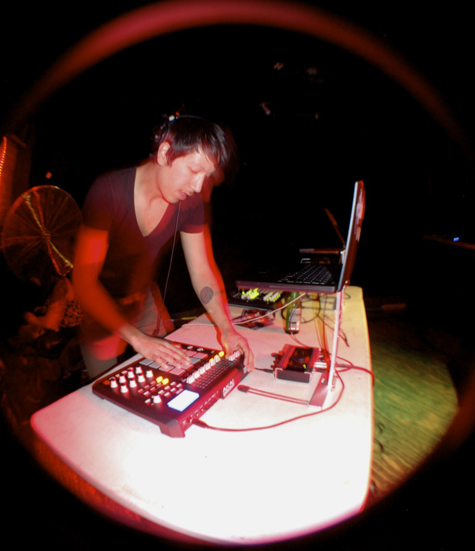
HUMP is a dance music night, for starters. It’s a night for the sweatmakers and the drinkers. DJ Jonathan Francis is towering over his laptop, face lit from the glow of his screen, and he’s busy selecting just the right tech-house and electro tracks. He likes variety, but tonight it’s funky bass lines cut with choppy vocal samples and noisy bridges with lots of cymbals. It’s hard not to move to this. The criticism is that it gets old after a while, but so does your grandma and you still love her. He throws on a Friendly Fires remix, and I’m sold.
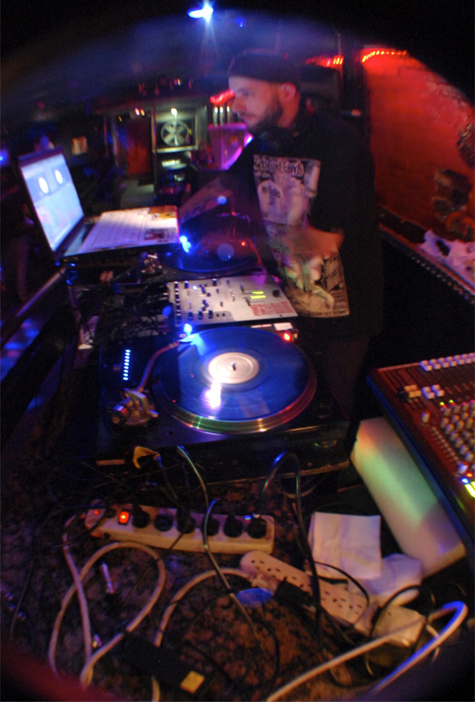
DJ Whores steps up to the plate. It’s 11 p.m. and everybody is primed and ready for one of Sacramento’s best selectors. He opens up the sound, choosing big vocal house cuts with chewy bass lines and devastating kick drums. Whores’ track selection is like a binder full of hall of famers. You’re stoked on a Ted Williams and then he hits you with a Mickey Mantle. It’s tough to say that he’s “warming up” Apache Cleo, tonight’s headliners, because Sacramento shows up just to hear this guy spin on a regular basis. Tonight is no different and I hang on his every mix, watching his fader carefully, anticipating the change like a nervous prepubescent.
As per a typical Midtown crowd, the club starts filling up around 11:30 and all the nightowl regulars are starting to show their hoodie-shadowed faces. Whores is in full swing by now and the randoms attracted to the word “Club” on the marquis have filtered in, too. All the right players occupy the dance floor, and all the while the lights are spinning and the drinks are weighing in. The sub is rattling frames and feet are sashaying across the floor like cursors on a Ouija Board, their movements uncontrolled.

The stroke of midnight finds Apache Cleo poised and ready. The duo is an attractive, young couple, with cute matching his-and-her laptops, whose DJ merits are defined by their individual styles that sonically mesh. Usually they perform together, but due to issues with the airport on Cleo’s computer, they are unable to link up and will be performing separately. Apache makes his way up first, preparing for his intro cut. It’s a dark house break, dissident and not the friendliest dance floor groove. Cleo circles him, dancing behind him and snapping photos of his every move. She seems to lighten his mood a bit because the next track he mixes in is a funky, disco banger that changes the atmosphere entirely. This is his way of letting the dance floor know he still cares–but not for long. His next track is just as ominous as his opener. The rest of his set is equally as unpredictable, but still full of gems that separate him from the others. He finishes with a Blondie remix that seems to summon Cleo, who saunters to her laptop. Her opening track is a strange rock anthem that sounds as if Cookie Monster is the singer. Again, her set is scattered yet enjoyable, even though she seems to be suffering from some technical difficulties. By this point, a couple is damn near making babies on the dance floor as a Missy Elliot lyric rings out, “Doing it, and doing it, and doing it well.” That’s my cue. I’m all humped out.
Artist Jared Konopitski Makes Mixed Things Match
Maybe it’s just a negative stereotype that creative people—you know, musicians, artists and people who go out and get drunk alongside musicians and artists—just aren’t morning people. Artist Jared Konopitski, a Midtown boy, born and raised, was waiting for our phone call at 9 a.m—bright-eyed, bushy tailed and sounding rather chipper. So maybe he is a morning person, or maybe it was the sugar high from the bowl of mango ice cream he’d just eaten. Ice cream for breakfast—he is an artist after all.
Artist is perhaps too narrow a term for Konopitski. Polymath may be more apt. Colored pencils, paints, photography, pencil and ink, Shrinky Dinks (huh?) are just some of the media he’s used during his career. Often, these different media will blend and bleed into one another in Konopitski’s work.
“It’s something that I would say I’ve always done as far as multiple mediums,” he says of his artwork. “They crossover as I learn more mediums. I just get bored, I guess, so then I try to explore, and then I come across something like Shrinky Dinks, and then they come together and it creates all kinds of eclectic work.”
This sort of mixing and matching has made Konopitski’s work not so easy to categorize, even for the artist himself, though he says he tends to lean more toward tattoo culture, cartoon and comic art—and, though he’s a bit loathe to say it, lowbrow culture.
“I think [lowbrow] was a term created by that culture, and in retrospect, they wish they hadn’t come up with that term,” Konopitski says.
Whatever you call it, there’s no denying the charisma of Konopitski’s art. Whether it’s brightly colored illustrations, real-life photographs enhanced with his goofy characters, or the painted Scotch tape sculptures he created in collaboration with Danny Scheible, Konopitski’s work speaks of a limitless imagination and exudes a fun, lighthearted vibe. His latest solo show opens April 2, 2010 at Cuffs Urban Apparel in Midtown. When Submerge spoke with the artist, he was taking a much-needed break from preparing for the exhibition. He says he hopes to have 30 pieces done in time for the show. The works he’ll have on display will be mixed media pieces involving spray paint, vinyl records and Shrinky Dinks. Konopitski says that a few samples of the pieces can be seen on his Facebook page, but he urges those who are curious to check out the exhibit for themselves. We here at Submerge believe you should do the same. It’s a bizarre mixture of materials to be sure, but you know how those artist types are”¦
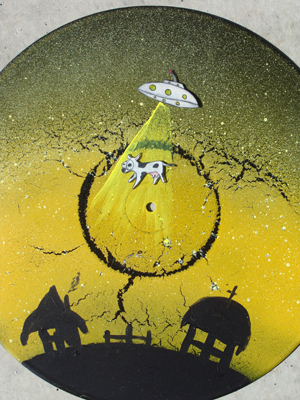
Are Shrinky Dinks something that you grew up with?
My mom actually introduced them to me. She pulled out her whole antiques there, her charms, and was showing me these little Shrinky Dinks, and I hadn’t heard of them since then.
I didn’t realize they still made them.
I actually ran into a place that was selling blank Shrinky Dinks sheets—just blank sheets like paper. But yeah, I just started making them myself and cutting them out. They’re awesome.
Does the medium you’re working with inform the artwork at all? Does it shape how you create a piece?
Absolutely. Say if I’m working with pen and ink—I don’t know if you’ve seen the tribal works I do—but they become more tedious, more detailed. If I’m working with colored pencils or Shrinky Dinks, they become more cartoonish. I made these sun prints”¦ That’s a whole different technique right there. Those result in creating cutout, silhouette styles and putting them on this paper that’s been chemically laced to react to the sun. So the medium dictates the style I’m going to do.
I saw that you work as a curator also. Is that a big separation for you, working as an artist and working as a curator?
Actually, that’s something I haven’t done frequently, but I have done for a few years. Basically, it’s a thing where I want to see this show, and I want to put this show somewhere, let me find a venue and put this call for art out to all kinds of people and put out a show I want to see, really. It’s like, this kind of show doesn’t exist and I want to see it.

Has working as a curator opened your eyes to how to present your work to other curators?
It helps with networking, I’d say, because then you’re working with other artists, and you’re giving back to them a little. As they find other shows that they’re curating themselves—I’ve found that a lot of artists, once they’ve been showing for so long, they’re also asked to put on shows as well, and they’ll say, “Hey, he gave me a show, why don’t I get him involved too.”
Was it something you went to school for?
I graduated with an AA from the community college, and I was going to move on to the Art Institute, but it seemed at that point that school was going to distract me from what I wanted to do, looking at the students’ work and such. Some of my favorite artists didn’t even go to school. They were all self-taught, so I thought I would save some money and not get all those student loans and try it myself.
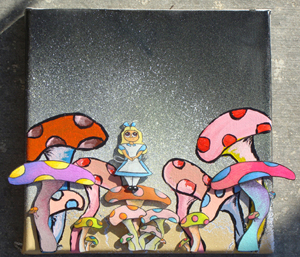
We were talking about how the materials you use inspire your artwork. How did working with Shrinky Dinks and records shape your work for this upcoming exhibit?
As far as that goes, it’s kind of a new medium working with acrylic and Shrinky Dink combined. These are the most I’ve done in that way, I guess. They’re all vinyl records, so they’re all circular canvases, and for some reason, I don’t know if it’s because it’s a different shape, but it’s inspired me more than a square canvas. I can’t stop coming up with ideas for it. It’s been a blast. I have more ideas than time.
Has it been a lot of trial and error working with the Shrinky Dinks? I remember when I’d put them in the oven, they’d get all curled up.
This is true. In fact, I didn’t even know that they got so curled up so much at first, so I would take them out of the oven and they’d just be round, curved balls of plastic. I almost gave up, but then I read the instructions, which I don’t do too often, and it actually said to leave them in there longer and they’ll flatten out. I guess that helped out there.
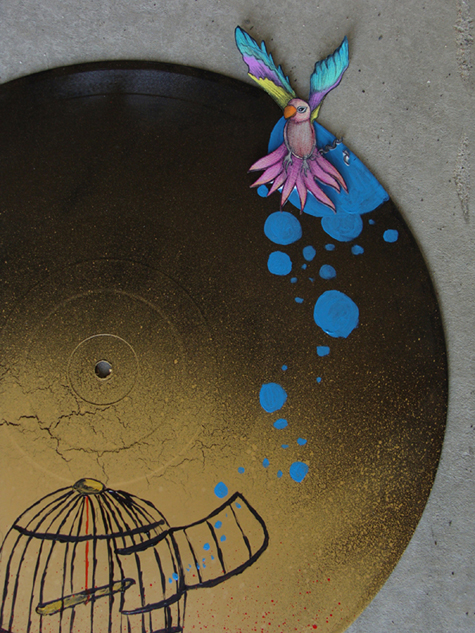
What excites you most about working in the Sacramento art community?
What excites me most is that the artists are so talented. The city is full of talented artists. But what the city doesn’t know, and I didn’t even realize this until I started showing art more, is there aren’t only immensely talented artists, but there are also people who are either traveling through or live here and don’t want people to know that they live here who are big in the art world. There’s folks who have been shown in Juxtapose, High Fructose and those art magazines; there are folks who’ve worked for DC Comics and Marvel Comics, there are folks who know people who make the Cartoon Network shows and Pixar and stuff. I had no idea I’d get to meet these people. I thought I’d show some art in the little town I grew up in, but I had no idea Sacramento secretly harbors these people.
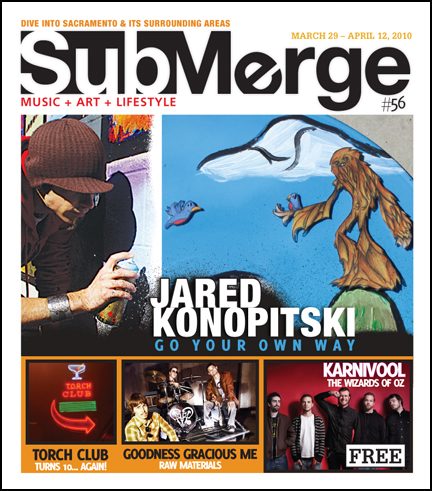
Check out Jared Konopitski’s work at Cuffs Urban Apparel starting April 2, 2010. For more information, go to www.jareko.com or look him up on Facebook at www.facebook.com/ people/Jared-Konopitski/838283475.
Tycho
Tycho and the Command Collective look to the next decade of Sacramento Electronica
Sacramento is a cowtown; we cannot escape that fact. Living in a city disrespected by the rest of California keeps us out of the Hypemachine, to a fault, but it’s also a benefit. Our artists move to San Francisco and blow up, resulting in press that neglects to mention origins prior to the Bay Area. Ambient electronica darling Tycho is one of our lost children. But not lost entirely as Tycho, who in a brief interview, enlightened me to the reunion of a lost scene he once helped cultivate in his true hometown.
“We used to have this thing called Command Collective,” Scott Hansen said. Hansen is Tycho, and Tycho is on the rise in national exposure with the Coastal Brake 12-inch on Ghostly International. Hansen was raised in Fair Oaks and lived in Midtown for eight years, where he made his first two (and a half, somehow) albums. Circumstances lacking relevance to this story resulted in Hansen moving to San Francisco, but he spoke with candor of his fledgling years in Sacramento designing Tha Fruitbat’s album art, Blue Bell compilation covers and Command Collective show posters.
“Doing those show posters and compilation covers were the impetus to my whole style,” he said. “I talk about it like it was a big deal in my career, at least in my head, but I don’t know how much of an impact it had on the random people who went to the shows.”
The early Noughties were ripe with enthusiasm for electronic music. A new millennium aroused hope of flying cars and space-age fabrics that would dress us down in shiny suits. Electronic music, devoid of organic instruments made of brass, wood, sheep intestines, gourds and bones, was an evolutionary step providing temperance to our insecurities about relying on advanced technologies as the providers of aural fascination. Unfortunately, for some, watching a nerdy dude stand at a laptop, nodding to his push-button performance lacked the visceral visual aesthetic of rock star power poses and frenetic shirtless drummers drenched in sweat.
Opinions varied, but according to reports, there was a consensus that between 2002 and 2004 Command Collective shows at Espresso Metro were “the scene.” For those who lived for it, it was a window of fortunate times. For some outsiders trying to understand the emerging scene, attention spans were tried with grueling self-indulgent sets.
“It was a pretty loose deal,” Hansen said. “It wasn’t like we were a group making music together. The reality of it was we were the only electronic musicians in Sacramento. We might as well play these shows together rather than open up for a bunch of rock bands.”
Command Collective was Dusty Brown, Evan Schneider (who operated as Tha Fruitbat and formed the groups Hysteresis Loop and Two Playa Game), Park Avenue (now known as Lifeliner), Tycho and Chachi Jones. DJ Mupetblast was the resident DJ of the collective, filling in the downtime between sets at the Metro. “Donald [Bell, Chachi Jones] and Tycho put [the collective] together to reel in all the top dudes from the different crews that were doing beat shows,” Schneider said. The collective focused on IDM, jungle and ambient sounds. There was a dance scene, that cannot be ignored, but it was another scene entirely.
Schneider began in ’98 with his band Hysteresis Loop. He and Dusty Brown came up together as operators in the drum and bass scene at raves and underground venues. Later, Schneider and Dain Fitzgerald, known as DJ Mupetblast, had Synthetic Sundays, a weekly (later became monthly) night of electronic music at The Press Club.
Schneider said the impact of Command Collective as a voice for the electronic scene resulted in the inclusion of an electronica award in The Sammies. The addition was prompted by a biting letter from Bell to the editor, who responded to a negative review of a Metro show. “He was the writer in the group,” Schnieder said. “It was great that he used his skills to volley some back at the critics.”
Several factors contributed to the dissolution of Command Collective. The Rave Act limiting the underground shows, a dwindling support of electronic music by venues, promoters and fans, the revivals of rock and folk as respected genres and the collective’s members’ lives changing. Chachi Jones moved to San Francisco for a six-figure editing job, and Hansen had his journey to pursue as well. Everyone carried on, but the name slowly dissipated with the scene.
“It felt like things died a couple years after it got started,” Hansen said. “Metro got sold, which was one of the only venues sympathetic to our cause at the time. People knew about those shows and it was a really cool centralized location. After that [closed] the whole movement lost steam.”
As for the “dude at a laptop” performance criticism, Schneider said it was a crutch of the era adapting to change. “When you’re someone who started with racks of samplers, synths and shit and you finally get a laptop with all that built inside of it, you do have a whole studio onstage. It’s just hidden,” he said. “It also wasn’t very affordable for any of us to do a sick multimedia show.”
Therein lies a vital adaptation by electronica, the inclusion of visual aids to pull your attention away from the man at the laptop. Tycho’s live set is ripe with live tweaked visuals based around his graphic design. Schneider said he tries to bring a “video guy” to his bigger shows as well.
When Hansen blogged on his ISO50 design Web site about the Sacramento Electronica Music Festival, he did not hesitate to mention the partial reunion of Command Collective; partial because Chachi Jones is not playing. The SEMF could be the first step in a resurgence of the scene and Schneider feels the climate is right for it. “Everybody is stoked on the post-Command Collective stuff,” he said in regards to Tycho. “The scene has expanded as far as people making more diverse music. Most of the indie rock and IDM people have heard of Tycho. I’ve been to Seattle and have people know who Tycho and the Command Collective are.”
When Hansen attends shows that Dusty invites him to, he gets the occasional scene supporter of yore regaling him with “I miss those days” comments. Besides nostalgia for the tight-knit scene he once cultivated, Hansen said he misses Sacramento in general. Schneider said with the name garnering a buzz, he hopes for an integrated scene once again. He mentioned Sister Crayon and CityState as the fresh talent emerging that could bring new life to the scene. “My exposure to the scene now is whatever Dusty is doing,” Hansen said. “From what I’ve heard from Dusty, things are on the upswing again.”
Catch Tycho along with a long list of performers at the Sacramento Electronica Music Festival from Jan. 28-30. For a full lineup and more information, go to www.sacelectronicafest.tumblr.com

